|
|
review
|
NEW>> Rude Awakenings: Two Englishmen on Foot in Buddhism’s Holy Land
by Ajahn Sucitto and Dr. Nick Scott
Wisdom Publications 2006
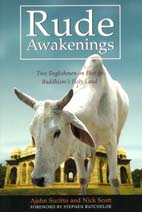 Why would any Westerner want to walk through the teeming chaos of crowded, noisy and polluted Indian towns, scorching hot agricultural plains and dangerous mountains prowled by bandits? In Rude Awakenings: Two Englishmen on Foot in Buddhism’s Holy Land, my answer was found in how eagerly I flipped through the pages. Why would any Westerner want to walk through the teeming chaos of crowded, noisy and polluted Indian towns, scorching hot agricultural plains and dangerous mountains prowled by bandits? In Rude Awakenings: Two Englishmen on Foot in Buddhism’s Holy Land, my answer was found in how eagerly I flipped through the pages.
This is a story of a pilgrimage undertaken by Buddhist monk Ajahn Sucitto and wildlife ecologist Dr. Nick Scott. Their journey is a devotional and contemplative exercise on the Buddha’s teachings of impermanence, suffering and selflessness. Wandering for six months across a thousand miles, these pilgrims vow to live as the early Buddhist wanderers did: eating only one meal a day acquired on alms-round, travelling by foot, sleeping outdoors and meditating all night.
Rude Awakenings is Sucitto and Scott’s first-person, no-holds barred account of their journey through India’s Middle Land. Ajahn Sucitto, a senior monk in the Thai forest tradition, is known for his austerity, deep knowledge of the Dharma and complete ineptitude when it comes to anything worldly. As a monk, he follows the 227 monastic precepts to the letter as a form of spiritual discipline and a desire to maintain the 2500-year old tradition.
Nick Scott, Ajahn’s loyal lay attendant and all-around trouble-shooter, has a soft spot for food, women and the wonders of nature. While admiring Sucitto’s ability to renounce all things transitory, Nick-the-layman’s sensory radar is always on the lookout for the next meal, a rare plant or an exotic bird. The spellbinding story is told as a ping-pong match between the ascetic renunciate and the life-loving householder in their distinctive voices, fusing together travel observations, cultural commentary and historical analysis with drama and self-effacing humour.
The simple, yet profound realization they have is that the journey is more psychological than geographical. Sucitto observes, “The land always looked much the same, in paddy fields stretched out and scantily decked with clumps of mango, banyan, and bodhi trees....progress was a matter of being undone and swallowed by the forces around me: the bantering inner and outer voices, the sweat and grime, the grit in the throat. Balance came through simply focussing on these things.”
This grounding record stirred memories of my own pilgrimage to the Middle Land where emotions were aroused, limits tested, and insights blossomed. Inner changes arose not simply from paying homage in the very place where the Buddha walked, but from facing persistent beggars and eager hawkers, the taunts of immature teenage mobs, and curious crowds. While these challenges often produced intense inner turmoil, my Dharma practice showed only one way out: moment-to-moment cultivation of mindfulness, equanimity, and compassion. This was the heart of my pilgrimage experience.
Despite this story being published almost fifteen years after the pilgrimage took place, the book’s spiritual insights from the road and commentary on life in India are timeless. Rude Awakenings conveys the down-to-earth richness of the Buddha’s teachings in an intimate context, making it a terrific read for anyone who has embarked on the inner journey.
-Kory Goldberg
back to top Practicing Peace in Times of War
Pema Chodron
Shambhala Publications 2006
 Intrigued by the soccer mom turned Buddhist monk, I picked up Pema Chodron’s recent book Practicing Peace in Times of War with a glint of skepticism. War is an immensity of which I know little except that I am a part of it. No single answer to its woes and complexities could be found in a hundred-page transcription of a lecture. Intrigued by the soccer mom turned Buddhist monk, I picked up Pema Chodron’s recent book Practicing Peace in Times of War with a glint of skepticism. War is an immensity of which I know little except that I am a part of it. No single answer to its woes and complexities could be found in a hundred-page transcription of a lecture.
For the past two years I have been studying Peace and Conflict, and found at the heart of conflict and reconciliation is a call for more dialogue. While the globe is immersed in dialogue, self with other, nation with nation, wars continue. It is not simply about confusion, or not communicating, or misunderstanding; war is a human reaction. What I gleaned from Chodron is her definition of war, as a tree grown from a seed planted in individuals. “War and peace start in the hearts of individuals,” reads the first line of her book. For Chodron, war encompasses inner strife, family relations, work dynamics, schoolyards, and expands into national and international boardrooms.
The book’s main message is “let go”; there is nothing to hold onto, and by holding onto a sentiment of stability, harm and suffering are increased. Basically, Buddhism in a sentence. The practice Chodron advocates is patience with self, with others, with the practice itself.
The practice of peace is begun by breaking down habitual responses. To effect change we must transform, not react. To develop peace one must feel pain, yet not perpetuate that pain by reacting with harm. War, as pain, leads us into deep uncertainty. Chodron speaks about the necessity of being seriously rattled, insecure in ourselves, in the world around us, as it is through such insecurity that new responses are enabled in place of habitual reactions.
“Becoming intimate with pain is the key to changing at the core of our being… Let difficulty transform you,” writes Chodron. Peace, she states, is only cultivated through vulnerability, what she terms “staying in the soft spots” when we are threatened or harmed. Aggression, fear and war are defence mechanisms against our softness being touched. The work is to soften a heart that is hard, and open a mind that is closed.
After closing the book, I read the newspaper. Cancer, turmoil, AIDS, famine, reads headline after headline. I am left reeling. I grapple with my ability to classify information into categories, habitually reacting to pain and suffering with aversion. I am a network of sense systems; can I surpass instinct?
My attempts to understand why I react in particular ways, what triggers my anger, why I allow others’ curt remarks to bait my reactions continue. My practice becomes staying with the ambiguity, remaining in the unknown despite my discomfort. Discomfort, writes Chodron, is the place for transformation and change.
While Chodron reminds us that indeed the power of change is within, there remains a need for naïveté, for unknowing, unlearning cultural myths, unlearning my own story, for my belief in peace to remain. Yes, practice is necessary, yet seeds of peace that grow into seedlings require soil to grow further. What is that soil? While the field work or practice is to “let go,” I wonder if patience is enough. – Anne Readback to top Leadership and the New Science: Discovering Order in a Chaotic World
Margaret J. Wheatley
Berrett-Koehler Publishers 2006
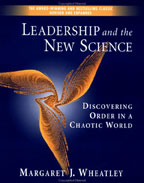 “Chaos is necessary for a new creative ordering,” writes Margaret Wheatley in the third edition of her classic book, Leadership and the New Science. She investigates how nature brings order out of chaos and how we can use those discoveries in our own organizations or communities, whether they are a family, a small business, a country or the world. She sees organizations as living, growing and changing entities and encourages leaders to embrace disruptions, disorder, confusion and chaos as signs of movement. We often see control as order, but life is change – a dance that incorporates the millions of possibilities available at any given time. “Chaos is necessary for a new creative ordering,” writes Margaret Wheatley in the third edition of her classic book, Leadership and the New Science. She investigates how nature brings order out of chaos and how we can use those discoveries in our own organizations or communities, whether they are a family, a small business, a country or the world. She sees organizations as living, growing and changing entities and encourages leaders to embrace disruptions, disorder, confusion and chaos as signs of movement. We often see control as order, but life is change – a dance that incorporates the millions of possibilities available at any given time.
By delving into quantum physics, biology, chemistry, chaos theory, fractals and life’s capacity for change, Margaret Wheatley offers her ideas of how these new sciences can make sense of the world. “We live caught between a world-view that no longer works and a new one that seems too bizarre to contemplate.” If we look at our current world affairs, we have recently been confronted with natural disasters and “global terror.” In some situations we have had heroes, and in others we have had leaders that didn’t know how to respond to the chaotic events.
How do we learn to cope with chaos and not create more, especially as the instantaneous communications and connections of our global community bring so much true and false information into our lives? What Wheatley points out is that in many groups communication is based on horizontal networks that are ad hoc and far more adaptable to change than organized hierarchical forces. This gives amazing resiliency in chaotic times of change or disaster.
We have seen heartfelt responses in many disasters and human tragedies such as Hurricane Katrina, where people bypass the red tape to help in whatever way they can. There have been huge steps forward with people self- organizing when organizations set up to help have failed. Wheatley comments that we “can rely on human compassion not to resist self-organizing.” We have to develop the courage to change our view of the world and our responsibilities in it. We are all co-creators of what is happening in our environment. “The future will remain uncreated until we engage in the present.”
First published in 1992, Leadership and the New Science is a classic resource for anyone dealing with issues of leadership within organizations. Margaret Wheatley is a writer, consultant, teacher, and co-founder of the Berkana Institute, a global charitable foundation dedicated to life-affirming leaders. This book and her work are powerful ways to rethink the way we live and lead. – Swami Radhanandaback to top The Visionary State: A Journey through California’s Spiritual Landscape
Erik Davis
Chronicle Books 2006
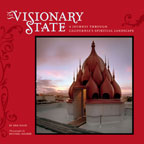 Erik Davis is our foremost chronicler of the mutant forms religion and/or spirituality take in contemporary culture. As such, his research has taken him to some rather strange places. His first book, Techgnosis: Myth, Magic and Mysticism in the Age of Information, brought together an encyclopedic collection of examples of apocalyptic spirituality, all of them mediated by technology, from scientology to Philip K. Dick, to psychedelics, to Marshall McLuhan. His second book is a remarkable 150-page exegesis of that great artifact of 1970s’ rock and roll album, Led Zeppelin IV, whose grungy but glorious spiritual aspirations, encrypted in citations from The Lord of the Rings and Aleister Crowley Davis, documents and appraises in a humorous but sympathetic tone. Erik Davis is our foremost chronicler of the mutant forms religion and/or spirituality take in contemporary culture. As such, his research has taken him to some rather strange places. His first book, Techgnosis: Myth, Magic and Mysticism in the Age of Information, brought together an encyclopedic collection of examples of apocalyptic spirituality, all of them mediated by technology, from scientology to Philip K. Dick, to psychedelics, to Marshall McLuhan. His second book is a remarkable 150-page exegesis of that great artifact of 1970s’ rock and roll album, Led Zeppelin IV, whose grungy but glorious spiritual aspirations, encrypted in citations from The Lord of the Rings and Aleister Crowley Davis, documents and appraises in a humorous but sympathetic tone.
Perhaps no surprise then that here Davis offers us nothing less than a history of spirituality in California, told in a series of meditations on particular places of significance to that history, and illustrated with photos by fellow Californian Michael Rauner. Like most of his previous objects of investigation, California has the status of a degraded object, the archetypal, parodic embodiment of New Age, credit card–assisted spiritual delusions and dreaming.
The clichés and indignation that accompanies them have a long history, running all the way back to Thomas Lake Harris, who founded a Theo-Socialist commune in Santa Rosa in 1875, espousing celibacy, practices of “Divine Respiration” and visualization techniques that Davis likens to “Victorian Tantra.” Harris was forced to flee in 1892 after being exposed by a San Francisco Chronicle reporter to whom he made sexual advances. Harris, along with California as a whole, is “cheesy” but “juicy,” to use two of Davis’ favourite adjectives. Davis obviously loves the paradoxes and contradictions that come with the territory, and shows how deeply California, as place, as idea is entangled in notions of spiritual renewal and reinvention in a series of booms, busts and eternal returns, that run from Mormon renegade Elder Brennan, founder of the first spa in California, to today’s Burning Man festival.
Davis acts as an archeological guide to a land littered with ruins, most of them less than one hundred years old. Asian religions fare relatively well in this spiritual demolition derby: the Kwan Tai Taoist temple in Mendocino, still active today, dates back to 1882 and the early waves of Chinese immigration to the west coast, while Ramakrishna and Vivekananda’s Vedanta Society Old Temple in San Francisco dates back to 1903. Paramahansa Yogananda wrote his Autobiography of a Yogi in Encinitas, still the home of a thriving ashram. Isherwood, Alan Watts, Huxley, Leary – the whole parade of literary and spiritual pranksters who made their homes in California at one time or another are in this book.
Davis’ conclusions, embedded in a final meditation on Californian sunsets, are optimistic: “In contrast with established religions, California consciousness affirms the modern condition, in all its vertiginous freedom. But it also seeks to transcend the narrow materialism of secular rationality, even as it reconciles spirit with a cosmic sense of the material world. Awakening today is a physical matter, rooted in the body of sensation and the ecological realities that pin us to this spinning ball. But consciousness also continues to surf the cusp of novelty, discovering a Promethean sensibility that is not content with limitations, earthly or otherwise.” It is unclear what the ocean here is – America? Capitalism? Nature? The Divine? – but there’s no question that the waves keep rolling in. – Marcus Boonback to top The Death of Religion & the Rebirth of Spirit: A Return to the Intelligence of the Heart
Joseph Chilton Pearce
Park Street Press 2007
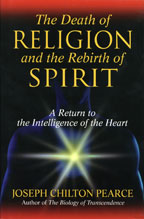 With his first book, The Crack in the Cosmic Egg, Joseph Chilton Pearce threw down the gauntlet and challenged his readers. Look! he said. Look at how much creative potential we have, how much intelligence human beings can express. Look at what we can be. With his first book, The Crack in the Cosmic Egg, Joseph Chilton Pearce threw down the gauntlet and challenged his readers. Look! he said. Look at how much creative potential we have, how much intelligence human beings can express. Look at what we can be.
He continued this challenge in subsequent books and hones the offer in The Death of Religion. Pearce exposes our vast evolutionary past and our possible future as a matrix that sets the stage for an exquisite possibility – to express our highest potential. And, he reveals how our cultural programming confines the possibility and limits it to acceptable norms.
Pearce draws from so many strands to clarify his ideas that a summary review is difficult. He writes of culture as a force field, brain development and evolution, nurturing and education, the theories of Darwin and Steiner, and the Eureka! moments of creative breakthrough.
One of many strands that intrigued me was the information about Charles Darwin’s later investigations. These led him to propose that it was love of self and of other that was the major evolutionary force, only able to manifest when the foundation work of natural selection was complete. This later theory, however, has been largely ignored while the earlier one became a foundation stone of science theory. Global culture has become a force dominated by values of prediction and control. It exerts tremendous influence on all facets – religion and science among them – such that it functions to bring conformity rather than illumination, obedience rather than creative insight, and mental abstraction rather than personal experience.
Looking at brain development, and especially at the prefrontal cortex (the most recently developed part of the human brain), Pearce describes an evolutionary process that set the stage for phenomenal intelligence to function. Instead, he writes, “Our newest brain is being dominated and over-ruled by the older models that function on instinct rather than intelligence.”
What has not yet manifested, though everything is ready for it to do so, is the intelligence of the heart, meant to function in harmony with that of the mind. The ongoing separation of heart and mind, Pearce claims, is the source of our destructive compulsiveness.
Pearce organized his ideas in this book into three sections. The first, “Culture as a Negative Field Effect and the Phenomenon of Mind,” gives the evolutionary and contextual overview. Part two, “The Conflict of Biology and Culture,” explores the relationship of brain growth and child-rearing practices. He confronts the reader, as Al Gore has done, with “an inconvenient truth.” The violence extended by humans to each other and to the earth itself is an unavoidable extension of a way of being that sets obedience and conformity against love (of self and other) and creativity.
But spirit, “life longing to express itself,” offers endlessly, through the heart, the possibility set out in part three: “The Rebirth of Spirit and Resumption of Evolution.” The work of waking up, opening the heart, engaging with creative newness is the work of nature’s wisdom and intelligence. This is Sophia, the Great Mother, and she functions through the heart. “Creating the world anew,” Pearce reminds us, “instant by instant, rather than following… the past and all its sorrows, is always our choice.” – Alanda Greeneback to top La Fin Du Monde
the Hylozoists
Boompa
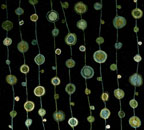 While sorting through the stacks of mail in ascent’s Montreal office, I came upon a La Fin Du Monde by the Hylozoists. Immediately intrigued by the cover lineup of musicians (which include members of Cuff the Duke, Fembots, Weakerthans, Broken Social Scene, Final Fantasy, and the Sadies) I popped the disk into my computer. Out came a fusion of Indie pop and dynamic, orchestral instrumentals. The whimsical, carnival-esque soundtrack churns out delicate melodies, interwoven vocals, and animated beats with an eerie undertone. I was instantly transported into a montage of theatrical sets – wandering through westerns, old European cafés, silent dramas, and in and out of carnivals, weaving together a mismatched narrative. While sorting through the stacks of mail in ascent’s Montreal office, I came upon a La Fin Du Monde by the Hylozoists. Immediately intrigued by the cover lineup of musicians (which include members of Cuff the Duke, Fembots, Weakerthans, Broken Social Scene, Final Fantasy, and the Sadies) I popped the disk into my computer. Out came a fusion of Indie pop and dynamic, orchestral instrumentals. The whimsical, carnival-esque soundtrack churns out delicate melodies, interwoven vocals, and animated beats with an eerie undertone. I was instantly transported into a montage of theatrical sets – wandering through westerns, old European cafés, silent dramas, and in and out of carnivals, weaving together a mismatched narrative.
Producer and multi-instrumentalist Paul Aucoin conceived the Hylozoists in 2001, though the collective didn’t come into its current star-studded form until he moved to Toronto in 2004. Aucoin’s classical training merges with his rock’n roll aesthetic, and overly apparent love of the vibraphone, to create a visceral rhythmic interplay throughout the album. In the spirit of this symphonic approach, the songs are dynamic - each accentuating a particular instrument and therefore, eliciting a different sensation. Hearts and Harps melancholy vocals and dramatic cello recall sorrowful departures and lost loves; Smiley Smiley’s rhythmic organ and overlapping pedal steel guitar evoke a medley of circus performers and ferris-wheels: illusions of fairgrounds throbbing with life; Elementary Particles is simple, melodious yet scattered with metallic buzzing and random whirls and peeps. It’s easy to get lost in the multitude of sounds, succumbing to their hypnotic dreamy trance – an unsettling side effect when you’re lost in a carnival dream sequence, though one I feel is intentional as it draws attention to the energy held within each note.
Hylozoism is “the philosophical doctrine that all or some material things possess life, or that all life is inseparable from matter.” Hearing the album illuminates why the Hylozoists adopted this title. There seems to be a preciousness and celebration surrounding each instrument and as I listen to the resonance of organ, trumpet, flugelhorn, vibraphone, glockenspiel, cello, viola, violin, baritone guitar, electric guitar and drums, each one comes to life and suddenly through the chaos, every note seems very distinct.
The title of the album, La Fin Du Monde or the end of the world, casts a heavy shadow over the music. I’m not sure if the collection is supposed to be celebrating life or mourning the worlds demise … maybe both. The last track of the album, similarly titled La Fin Du Monde, begins soft and fantastical: a lullaby weaving through rich blue skies with fluffy cotton clouds and twinkling stars. After a brief interlude of downhearted lyrics, the song and record ends abruptly with a startling cacophony of sound - as though every instrument used by the Hylozoists is yelling all at once. The tension between sound and silence resonates and the emptiness remaining is tangible. I become very aware of every squeak and rattle in the room and can’t help but wonder if there’s life in the object creating it.back to top Orphans: Brawlers, Bawlers & Bastards
Tom Waits
Anti 2006
 Tom Waits’ new album, Orphans, is a sprawling 56-song collection of rarities and unreleased material that spans over three hours. It is an exhaustive collection that speaks to the different songwriting styles that Waits has evidenced over his critically acclaimed 33-year, 20-album recording career. A few of his albums have been huge influences on my own musical creations, and more generally, Waits represents an ideal for songwriters to emulate. He has steadfastly followed his own muse, garnering widespread success born of a cult following, untouched (but not unaware) of the fickle tastes of commercial radio. Tom Waits’ new album, Orphans, is a sprawling 56-song collection of rarities and unreleased material that spans over three hours. It is an exhaustive collection that speaks to the different songwriting styles that Waits has evidenced over his critically acclaimed 33-year, 20-album recording career. A few of his albums have been huge influences on my own musical creations, and more generally, Waits represents an ideal for songwriters to emulate. He has steadfastly followed his own muse, garnering widespread success born of a cult following, untouched (but not unaware) of the fickle tastes of commercial radio.
A few truly great singer-songwriters can rely on an adopted persona and still move us emotionally. Bruce Springsteen is not the blue-collar Everyman he sings about, yet he has used this assumed identity to leave sincere impressions on his audience, and in turn, the American musical tradition. Similarly, Tom Waits has assumed and maintained an identity pulled from some forgotten Americana on the dusty fringes. His protagonists are boxcar storytellers, broken-down carnival ex-pats, and barroom saints looking for one last chance at happiness, and he is the gravel-voiced piano player telling their tale. His music is a rare combination of vaudevillian antics and morbid wit, but at the core of Tom Waits’ songwriting there is an emotional truth that cleaves through his theatrical smokescreen. It is this truth that Orphans’ three discs best display.
Growing up listening to Tom Waits albums, I quickly learned to suspend myself in the thick atmosphere he created. I found it more rewarding to accept that the bluesy, boot-stomp anthems and whiskey-throated ballads were part of some post-apocalyptic burlesque show that Waits was conducting, even though on a literal level they had little to do with my life. I spun the gritty albums on an aging record player until I felt that every nuance had seeped into me, changing the way I saw the world.
Throughout Waits’ career, his work has evoked a time and place that never really existed, but seemed just barely plausible. This type of songwriting is best found on Orphans’ first disc, Brawlers. These songs are mid-tempo, sepia-toned thumpers about trains, sin and redemption, and the worldly turmoil the lonely wanderer must face. Guitarist Marc Ribot slinks around engine-block percussionists and Waits directs the shuffling spectacle with a sandpaper voice and much-traveled perspective. “Lie to Me” and “Bottom of the World” are as good as anything Waits has ever done.
The second disc, Bawlers, sets the tone that most Waits fans revere–melancholy regrets and whispered apologies that only the night will hear. Muted trumpets, old-tyme radio scratchiness and brushed snare drums offset a softer side of Tom Waits’ voice. “Long Way Home,” for example, is a gorgeous, subtle heartbreaker whose parity shows how accomplished a songwriter Waits can be. Hearing some songs on Bawlers, it is clear that Waits could write the perfect ballad by simply singing over a metronome’s click.
The third disc, Bastards, represents Waits’ more experimental work, which is saying something given his career. Penned mostly for, or from, theatre pieces, including songs adapted from Bertolt Brecht work (“What Keeps Mankind Alive”), Georg Buchner’s plays (the very creepy “Children’s Story”) or pieces by Charles Bukowski (“Nirvana”), this collection showcases Waits’ weirdness and adaptability. Spoken word pieces and free-folk freakouts are placed side by side in a clash of styles highlighting Waits’ experiments with musical styles and forms. This disc is less likely to win over the uninitiated, but presented with the two other discs in the Orphans collection, stands as a superb overview of one of today’s most relevant, unique artists.
In the end, this retrospective of Tom Waits’ rarities cannot be easily summed up in a review. There are so many small stories and so many subtle colours in each song that I find myself simply submerging in the songwriter’s worldview. The three discs of Orphans showcase Waits’ spookier, more experimental tomes, his lonely rain-drenched saunters and his stein-swinging sing-alongs as much as anything in his career has. It is an album of mysterious characters and strange places that I will be visiting many times again. – Scott W. Grayback to top
|
|